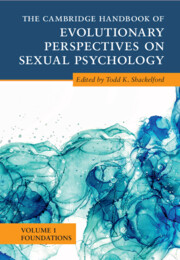Book contents
- The Cambridge Handbook of Evolutionary Perspectives on Sexual Psychology
- The Cambridge Handbook of Evolutionary Perspectives on Sexual Psychology
- Copyright page
- Contents
- Contributors
- Preface
- Part I Foundations of Evolution
- 1 Natural Selection
- 2 Sexual Selection
- 3 Inclusive Fitness Theory
- 4 Adaptive Problems in the Domain of Human Sexuality
- 5 Adaptations, By-products, and Spandrels
- 6 Evolved Psychological Mechanisms
- Part II Middle-Level Theories
- Index
- References
2 - Sexual Selection
from Part I - Foundations of Evolution
Published online by Cambridge University Press: 30 June 2022
- The Cambridge Handbook of Evolutionary Perspectives on Sexual Psychology
- The Cambridge Handbook of Evolutionary Perspectives on Sexual Psychology
- Copyright page
- Contents
- Contributors
- Preface
- Part I Foundations of Evolution
- 1 Natural Selection
- 2 Sexual Selection
- 3 Inclusive Fitness Theory
- 4 Adaptive Problems in the Domain of Human Sexuality
- 5 Adaptations, By-products, and Spandrels
- 6 Evolved Psychological Mechanisms
- Part II Middle-Level Theories
- Index
- References
Summary
Darwin found that many animals had characteristics that were difficult to explain in terms of natural selection (i.e., the gradual process in which organisms better adapted to their environment survive and reproduce more successfully over sufficiently long time periods). He proposed a new selective force, sexual selection, which refers to the process generated by differential sexual access to opposite-sex mates. The process of sexual selection, in its classic conceptualization, consisted of two components: male–male competition, resulting in built-in weapons, and female choice, resulting in ornaments. Following Darwin, sexual selection is often divided into two forms: (1) intrasexual selection, in which members of one sex, most often males, compete with one another to gain sexual access to opposite-sex mates; and (2) intersexual selection, in which individuals of one sex, most often females, choose among individuals of the opposite sex as mates. The two forms of sexual selection have been investigated in humans across cultures, producing a large body of work on psychological similarities and differences between women and men in the context of mating. Post-mating sexual selection and its effect on sexual psychology have also gained increasing research attention in the last two decades. Two post-mating strategies in sexual selection are discussed: sperm competition (the competition between the sperm of two or more males to fertilize the egg(s) of a single female) and mate guarding (behaviors used to maintain reproductive opportunities and sexual access to a mate). Previous applications of sexual selection to sexual psychology and future directions in integration of multiple perspectives in evolutionary social sciences are discussed.
Keywords
- Type
- Chapter
- Information
- Publisher: Cambridge University PressPrint publication year: 2022

